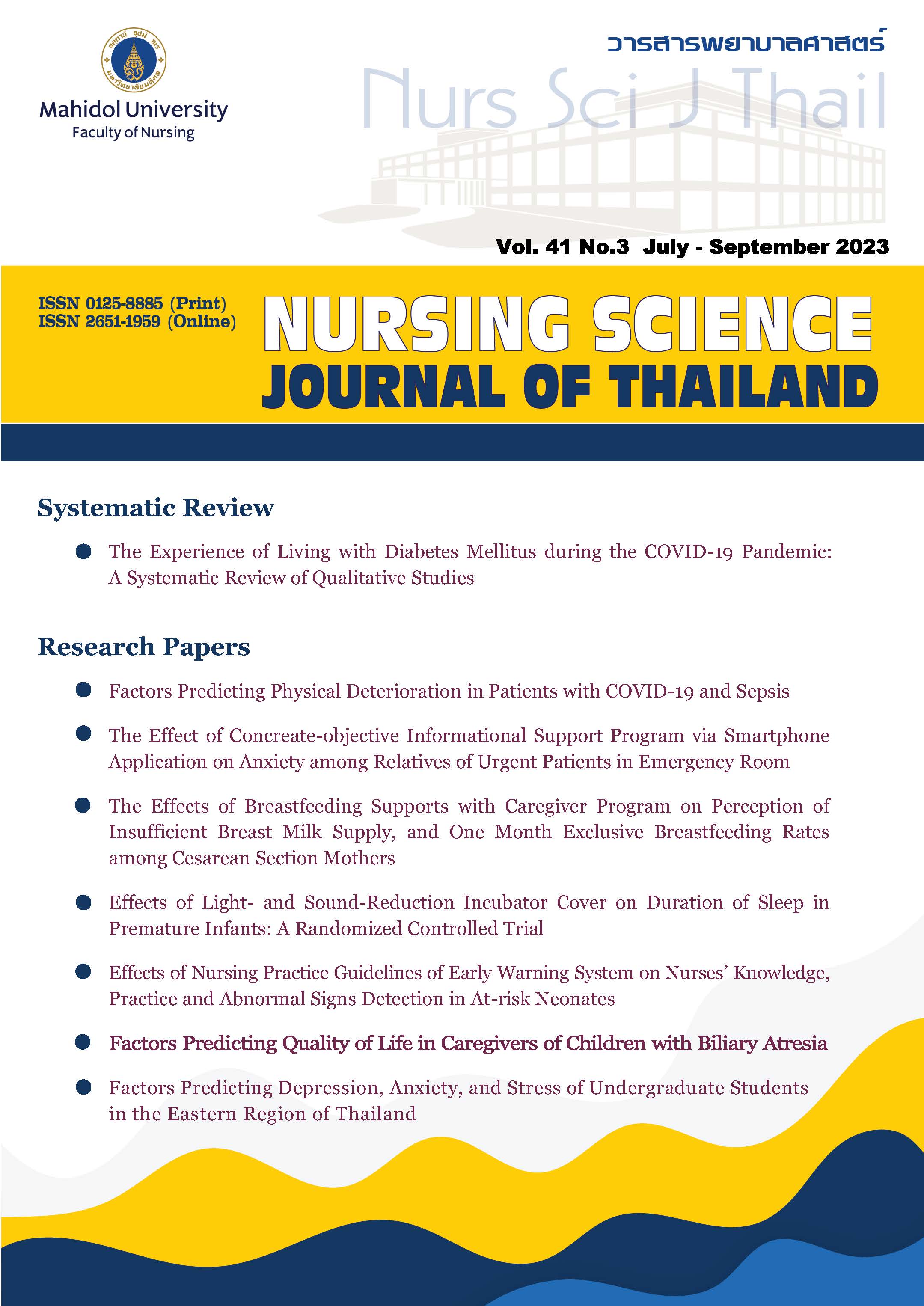The Effects of Breastfeeding Supports with Caregiver Program on Perception of Insufficient Breast Milk Supply, and One Month Exclusive Breastfeeding Rates among Cesarean Section Mothers
Main Article Content
Abstract
Purpose: To study the effects of breastfeeding supports with caregiver program on perception of insufficient breast milk supply, and one-month exclusive breastfeeding rates among cesarean section mothers.
Design: quasi-experimental pretest and posttest design with a comparison group.
Methods: The samples consisted of 103 mothers who underwent cesarean section and stayed at the postpartum unit in a tertiary hospital, Nakhon Sawan province. Fifty-two samples in an experimental group received the program combined with usual care, whereas 51 samples in a control group received only usual care. The instruments included personal information recording form, the H & H Lactation Scale, and the Infant Feeding Interview. Data were analyzed by percentage, mean, standard deviation, t-test, and chi-square.
Main findings: The mean scores of perceived insufficient breast milk supply in the experimental group prior to hospital discharge and at 1-month post discharge were significantly lower than that in the control group (t = 7.27, p < .001 and t = 3.55, p = .001 respectively). Within the experimental group, the mean scores of perceived insufficient milk supply after receiving the program prior to hospital discharge and at 1-month post discharge were significantly lower than that before receiving the program (t = 5.65, p < .001 and t = 2.62, p = .01, respectively). The rate of exclusive breastfeeding at one month in the experimental group and control group were not significantly different. (p = .18).
Conclusion and recommendations: Breastfeeding supports with caregiver program can help postpartum mothers with caesarean section on perceived sufficient milk supply. Therefore, nurse-midwives should apply this program to promote awareness of breast milk adequacy and exclusive breastfeeding rate.
Article Details

This work is licensed under a Creative Commons Attribution-NonCommercial-NoDerivatives 4.0 International License.
Copyright Notice: Nursing Science Journal of Thailand has exclusive rights to publish and distribute the manuscript and all contents therein. Without the journal’s permission, the dissemination of the manuscript in another journal or online, and the reproduction of the manuscript for non-educational purpose are prohibited.

Disclaimer: The opinion expressed and figures provided in this journal, NSJT, are the sole responsibility of the authors. The editorial board bears no responsibility in this regard.
References
Chaikongkiat P, Bunlap P, Harnnarong A. Factors related to breastfeeding self-efficacy of mothers after cesarean section. Nursing Public Health and Education Journal. 2020;21(1):16-28. (in Thai).
Senanayake H, Piccoli M, Valente EP, Businelli C, Mohamed R, Fernando R, et al. Implementation of the WHO manual for Robson classification: an example from Sri Lanka using a local database for developing quality improvement recommendations. BMJ Open. 2019;9(2):e027317. doi: 10.1136/bmjopen-2018-027317.
Sananpanichkul P. Concern of cesarean section rate. The Journal of Prapokklao Hospital Clinical Medical Education Center. 2018;35(3):312-20. (in Thai).
Liabsuetrakul T, Sukmanee J, Thungthong J, Lumbiganon P. Trend of cesarean section rates and correlations with adverse maternal and neonatal outcomes: a secondary analysis of Thai universal coverage scheme data. AJP Rep. 2019;9(4):e328-e36. doi: 10.1055/s-0039-1697656.
Mirahmadizadeh A, Moradi F, Zahmatkesh S, Abasi A, Salari A, Hassanipour S, et al. Evaluation of breastfeeding patterns in the first 24 h of life and associated factors in south of Iran: a cross-sectional study. Clin Epidemiol Glob Health. 2020;8(1):33-7. doi: 10.1016/j.cegh.2019.04.002.
Sinsuksai N, Nuampa S, Chanprapaph P. Factors predicting 6-month-exclusive breastfeeding in mothers with cesarean section. Nursing Science Journal of Thailand. 2017;35(1):14-22. (in Thai).
Zhang F, Cheng J, Yan S, Wu H, Bai T. Early feeding behaviors and breastfeeding outcomes after cesarean section. Breastfeed Med. 2019;14(5):325-33. doi: 10.1089/bfm.2018.0150.
Wang Z, Liu Q, Min L, Mao X. The effectiveness of the laid-back position on lactation-related nipple problems and comfort: a meta-analysis. BMC Pregnancy Childbirth. 2021;21(1):248. doi: 10.1186/s12884-021-03714-8.
Watcharaphao N, Chokdee P, Chukwan S, Lalit K, Niemnor N. The effectiveness of breast massage for stimulating milk flow in mothers after caesarean section Uttaradit hospital. Health Science Clinical Research. 2021;36(1):64-73. (in Thai).
Hill PD, Humenick SS. Insufficient milk supply. Image J Nurs Sch. 1989;21(3):145-8. doi: 10.1111/j.1547-5069.1989.tb00120.x.
Thummarattanakul K, Tongsawat T, Somboon L. Perception of insufficient breast milk: nurse-midwife role. APHEIT Journal of Nursing and Health. 2020;2(2):13-26. (in Thai).
Lou Z, Zeng G, Huang L, Wang Y, Zhou L, Kavanagh KF. Maternal reported indicators and causes of insufficient milk supply. J Hum Lact. 2014;30(4):466-73; quiz 511-2. doi: 10.1177/0890334414542685.
Sawatpanich A, Yimyam S, Chaloumsuk N. Factors influencing exclusive breastfeeding at discharge among first-time mothers undergoing cesarean section. Nursing Journal. 2019;46(3):219-31. (in Thai).
Phahuwatanakorn W, Soothampitag M. Comparison of breastfeeding problems during early postpartum between mothers with exclusive breastfeeding and mothers with non-exclusive breastfeeding at 1 month. Nursing Science Journal of Thailand. 2013;31 Suppl 2:57-66. (in Thai).
Anggraeni MD, Latifah L, Rismawati I. The effect of “insufficient milk supply” concept intervention on mother's perception of breast milk production. Indonesian Nursing Journal of Education and Clinic. 2016;1(1):71-4. doi: 10.24990/injec.v1i1.92.
Cohen J. Statistical power analysis for the behavioral sciences. 2nd ed. Hillsdale, NJ: Lawrence Erlbaum Associates; 1988. 567 p.
Hill PD, Humenick SS. Development of the H & H lactation scale. Nurs Res. 1996;45(3):136-40. doi: 10.1097/00006199-199605000-00003.
Srimoragot M, Kantaruksa K, Chaloumsuk N. Factors related to perceived insufficient milk supply among first-time mothers. Nursing Journal. 2021;48(3):354-65. (in Thai).
Wongphinit U, Sinsuksai N, Yusamran C. Personal factors, social support and effective suckling at discharge in predicting exclusive breastfeeding at one month among first-time mothers. Journal of The Royal Thai Army Nurses. 2016;17(1):88-95. (in Thai).
Ansook P, Kantaruksa K, Chaloumsuk N. Factors related to perceived insufficient milk supply among first-time mothers with cesarean section. Nursing Journal. 2020;47(4):192-202. (in Thai).
Ingram J, Johnson D, Greenwood R. Breastfeeding in Bristol: teaching good positioning, and support from fathers and families. Midwifery. 2002;18(2):87-101. doi: 10.1054/midw.2002.0308.


